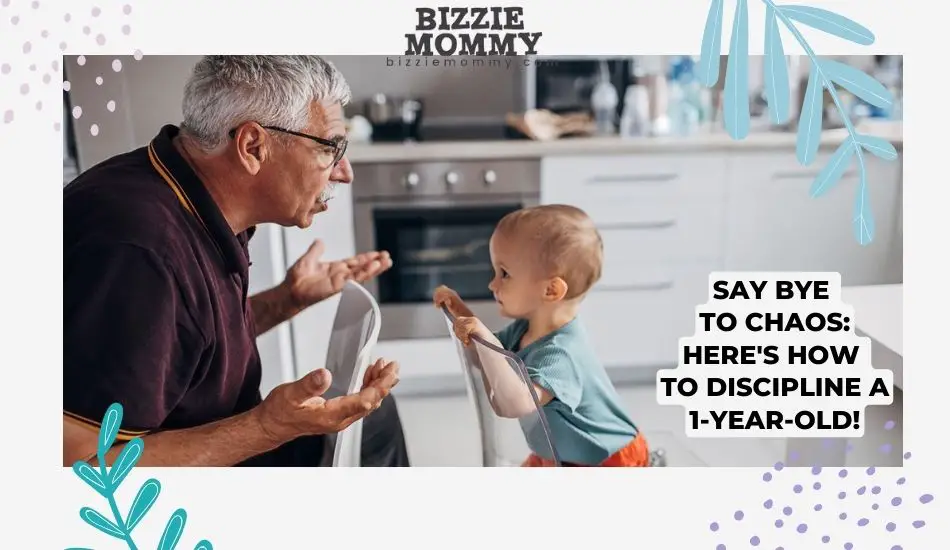Positive discipline strategies are a great way to discipline anyone, and they are surely good for one-year-olds too. While it will take some time for toddlers to understand what is right and what is wrong, with consistency and the right parenting style, they can be disciplined very well.
Some traditional discipline methods, like hitting your child if your child hits someone, or yelling at them, are wrong. Instead, you can distract them from the negative behavior by showing them their favorite toy or singing a song they like. One thing you should know is to focus more on their good behavior instead of their bad behavior. Praise them when they follow the rules so they will want to do it more.
How To Discipline Your 1-Year-Old
One-year-old toddlers require a lot of care and time with almost everything. One of the most common reasons that will get you working up with your 1-year-old is disciplining him/her because they will, without a doubt, wreak havoc whenever they can. It is just a part of them growing up and getting used to things.
But obviously, you cannot use adult techniques on a 1-year-old who can’t even understand basic commands yet. But that does not mean it is not possible. There are many positive discipline techniques many parents use that deal with the temper tantrums their toddlers are always throwing and allow them to discipline their toddlers without problems.
Can a One-Year-Old Even Understand Discipline?
When your baby is one year old, he/she is still in the early stages of development and won’t really understand discipline in its true sense. Discipline means teaching children the difference between right and wrong behavior. Even though a one-year-old may not fully understand these concepts, it is still very important to begin laying the foundation to start disciplining as they grow up.
One-year-olds are still exploring the world around them, learning new things every day, and developing the basic level of attachment with their parents. While they can possibly become familiar with a few words at this age, their cognitive abilities will still be very limited. So, disciplining young toddlers is going to be very different and a bit more difficult than what it would be with older toddlers or other kids.
Ways To Help Discipline Your 1-Year-Old
To teach your toddler discipline and proper behavior, here are a few practical tips you can use. Remember to remain calm and not throw temper tantrums yourself, and be as gentle as possible because it will take some time.
Use Of Positive Reinforcement
Positive reinforcement is a very effective discipline technique for one-year-olds. It basically focuses on encouraging toddlers to have good behavior. At this stage of development, children explore how the world works and learn new things, especially by imitating those around them. Positive reinforcement means praising them when they behave well, paying attention to them, and giving them rewards when they behave well, which helps reinforce those behaviors and encourages them to keep on acting the same way.
The key to success with this with one-year-olds is to make it quick, specific, and genuine. When the child does something good, such as sharing a toy with a sibling or picking up their toys, react immediately by being excited about it and praising them. Use clear and simple language to describe the positive action, such as saying, “Great job sharing!” or “You are such a good helper!”
One-year-olds love attention and being praised by others. Positive attention and affirmation make the child feel valued and appreciated, boosting their self-esteem and motivation to continue behaving positively. You can also go for physical affection like hugs and high-fives. Physical touch provides a sensory reward and strengthens the connection between the child and his/her parents.
Another valuable form of positive reinforcement is when you reward good behavior with small, age-appropriate gifts. For example, you could create a sticker chart and let the child place a sticker on it every time they accomplish a specific positive task. Once they collect a certain number of stickers, they can receive a small treat or do something they really like, like going to the mall or something. The rewards should be simple and age-appropriate to maintain their effectiveness.
Issuing a Fine When They Act Out
This is also a good way to make the children understand that their negative behavior is not just something that you are merely stopping them from but something with actual negative consequences. Children this young rarely ever deal with the consequences of their actions, and a little bit of indiscipline is to be expected, but putting an age-appropriate punishment on them when they act out is a great way to make them understand that their actions do have consequences.
First and foremost, it is very important to understand that a one-year-old’s behavior is a natural part of their developmental process. Tantrums, acting out, or other challenging behaviors are often their way of expressing emotions, needs, or frustrations they cannot yet communicate verbally. By acknowledging and validating their emotions, the child feels secure and learns that their feelings are respected, helping to build a strong foundation of trust between the child and caregiver. You, as a parent, must know that the child will never be on the same page as you emotionally or intellectually, so you will have to go the extra mile to make them understand what exactly they did wrong and why it was a bad thing. Use as many positive words as you can, and first, calmly explain to them what they did wrong. Then explain why they are being punished.
The punishment could be easy like cleaning up their toys, not playing with them, not letting them watch TV, or some sort of confiscation of possession like taking away their toys. Remember that when you are finding the child, the child is going to be a little overwhelmed or highly emotional, so be very loving and caring, and do not lose your cool even if you feel frustrated. Take some deep breaths if you feel overwhelmed. You must pair this method up with positive remarks about their positive behavior and a discussion for it to be effective.
Distracting Them

You will definitely feel challenged when you discipline toddlers since they are still in the early stages of development, have a limited understanding of rules and boundaries, and don’t have much self-control. At this age, discipline should focus on gentle guidance rather than punishment.
One effective strategy for disciplining a one-year-old is using distractions to get their attention away from undesirable behaviors. Distraction is a useful technique because one-year-olds are naturally curious and easily captivated by new things. When toddlers misbehave intentionally or start to get upset, distracting them with something interesting or fun can help shift their focus. This will help you stop the negative behavior from getting off limits.
When using distraction as a discipline method, observe the child’s cues and triggers to be ready for any potentially challenging situations. For example, if a child starts reaching for sharp objects, quickly stop them by offering a colorful toy or a soft toy. You can say something like, “Look at this fun toy! Let’s play with this instead!”
Toys that make sounds have bright colors or offer some activity that your baby likes to do. Engage them in interactive games or activities that they enjoy. Peek-a-boo, singing songs, or imitating animal sounds can be entertaining for a one-year-old and can quickly divert their attention from a potential meltdown.
Keep in mind that one-year-olds have short attention spans, so distractions need to be immediate and engaging. It may take some trial and error to discover what types of distractions work best for your child in different situations. Baby proofing any harmful or fragile things or using baby gates of fridge and oven door might be a good idea, too, especially in case your baby throws tantrums out of nowhere.
Being Consistent
Consistency is a key element when you discipline a one-year-old. Although they may not fully understand rules and boundaries, having consistent discipline practices is very important for their overall development and understanding of what is right and what is wrong. Here are some important aspects to consider when being consistent in disciplining a one-year-old:
Clear Boundaries:
Set limits and define simple and age-appropriate boundaries for the child. These boundaries could include not touching certain objects, gentle touch during play, or staying away from dangerous areas in the house. Make sure that everyone involved in caring for the child follows these boundaries consistently.
Set Expectations:
Communicate your expectations clearly, even though the child may not fully understand your words. Use simple language and gestures to convey what is acceptable behavior and what is not. For example, say, “Don’t throw food” if they are making a mess at mealtime.
Positive Reinforcement:
Use positive reinforcement to encourage good behavior. Praise and show affection when the child follows the set boundaries or does something good. This will motivate them to repeat these behaviors.
Redirect Unwanted Behavior:
One-year-olds are curious and may engage in undesirable actions. Instead of scolding, gently redirect their attention to an appropriate activity or toy. For example, if they are playing with something they shouldn’t, offer a suitable alternative and explain why that is a better choice.
Stay Calm and Patient:
Dealing with a one-year-old’s behavior requires a lot of patience. Stay calm and composed, even if they test your limits. Avoid overreacting to minor issues, as this might confuse or scare them.
Consistent Caregiver Response:
If the child is under the care of different adults, ensure that all caregivers respond to their behavior consistently. This helps the child understand that the rules apply regardless of who is around.
Timeouts:
While timeout is not typically recommended for one-year-olds, if a brief break from an activity is necessary, keep it short and use it as a way to help them calm down and self-regulate.
Be a Role Model for Good Behavior:
Children learn by imitating those around them. Model the behavior you expect from them, as they are more likely to follow your actions.
Avoid Physical Punishment:
Physical punishment is not appropriate for children of any age. It can lead to fear, aggression, and potential long-term negative effects on the child’s development.
As the child grows and develops, their understanding of rules and boundaries will improve. Be prepared to adjust your discipline strategies accordingly while always maintaining a loving and supportive approach. Consistency is the key to effective discipline for one-year-olds. By providing a safe and nurturing environment, setting clear boundaries, and offering positive reinforcement, caregivers can help the child develop a foundation for healthy behavior and social skills that will benefit them as they continue to grow and learn.
Stay Calm at Unwanted Behavior
Many parents struggle to discipline their toddlers because of how unpredictable and fragile they are and how these years can very well affect and change their child’s life, but with the options given above, it is possible to discipline your toddler. One thing you must remember is to be too strong-willed and have patience because it will take your child some time to understand which behavior is acceptable and which is not. It might be sooner than other children learn the same things, or it might be a bit later. There is no set time for how long it should take. However, if you are seriously concerned that something with your child might not be quite right because of his/her inappropriate behavior, there is no shame in connecting with a child psychologist, who can help you understand the issues better. But know that some things, like throwing food or toys, crying, or not wanting to do things, are normal for a one-year-old and are not a reason to worry.

